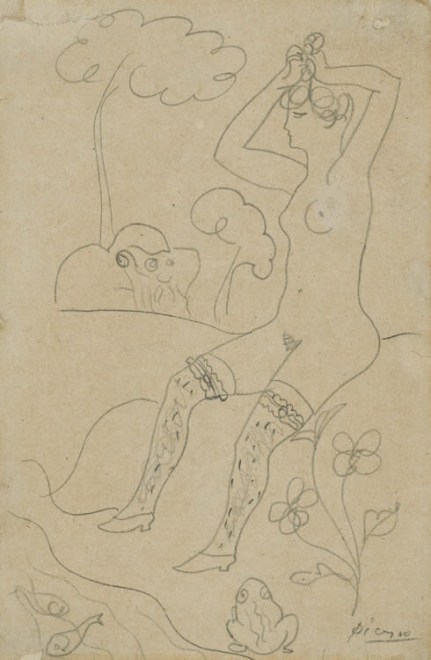Provenance
Bernard Poissonier, Paris, by 1954.
Anonymous sale, Sotheby's, New York, 7 November 1991, lot 129.
Drawn when Picasso was living in Barcelona circa 1903/4.
Literature
C. Zervos, Pablo Picasso, vol. VI, Supplément aux volumes 1 à 5, Paris, 1954, no. 609 (illustrated pl. 74).
Publications
Already by 1904 French and Spanish critics were enthralled by Picasso's dazzling paintings and drawings of the human figure.Writing in that year Carlos Juner-Vidal declared:
'In this sense Picasso is triumphant: the very conception of his figures expresses everything. They are admirably drawn and marvellously well balanced, without relying on line or the correctness of their proportion. Indeed, almost all his figures could be cast by a goldsmith or a sculptor; his hands have touched the contours of muscles, they have followed the curve of lines, they have felt the form of bones. This is what first appears to our eyes: a natural human type, in all its attitudes.'
The present drawing was formerly in the collection of the important French collector Bernard Poissonnier. He began assembling his collection during the interwar period, but little is known about how he acquired it. He owned at least four early works on paper by Picasso: Woman in Profile (1902–03; Zervos, vol. VI, no. 437), Couple in a Tavern (1904; Daix D. XI. 17), and Kneeling Nude (1904; Daix D. XI. 21) and the present drawing. His collection also included several works by Juan Gris, among them Bottle of Rosé Wine (1914; The Metropolitan Museum of Art, Promised Gift from the Leonard A. Lauder Cubist Collection), Bottle of Rum and Newspaper (1914; Peggy Guggenheim Collection, Venice), The White Tablecloth (1912–16; The Museum of Fine Arts, Houston), Hot Water Jug and Bowl (1916; Cooper with Potter 1977, no. 172), and Jug and Water Bottle (1925; Cooper and Potter 1977, no. 502). Poissonnier also acquired works by Paul Klee and at least five paintings by Giorgio de Chirico, which for a time the collector placed on deposit at the Kunstmuseum Basel.
A close friend of Jacqueline Apollinaire since 1936, Poissonnier contributed to cementing the legacy of her late husband, the poet Guillaume Apollinaire. In 1952, together with Robert Mallet, he compiled and issued a group of previously unpublished poems by Apollinaire. Later in that decade, participating as the General Secretary of the Apollinaire Committee, he worked on the construction of the monument dedicated to the poet in the neighborhood of Saint-Germain-des-Prés in Paris (Square Laurent-Prache) for which Picasso donated a sculpture. In the 1980s, Poissonnier gifted a collection of Apollinaire’s manuscripts to the Bibliothèque Nationale de France in Paris.
